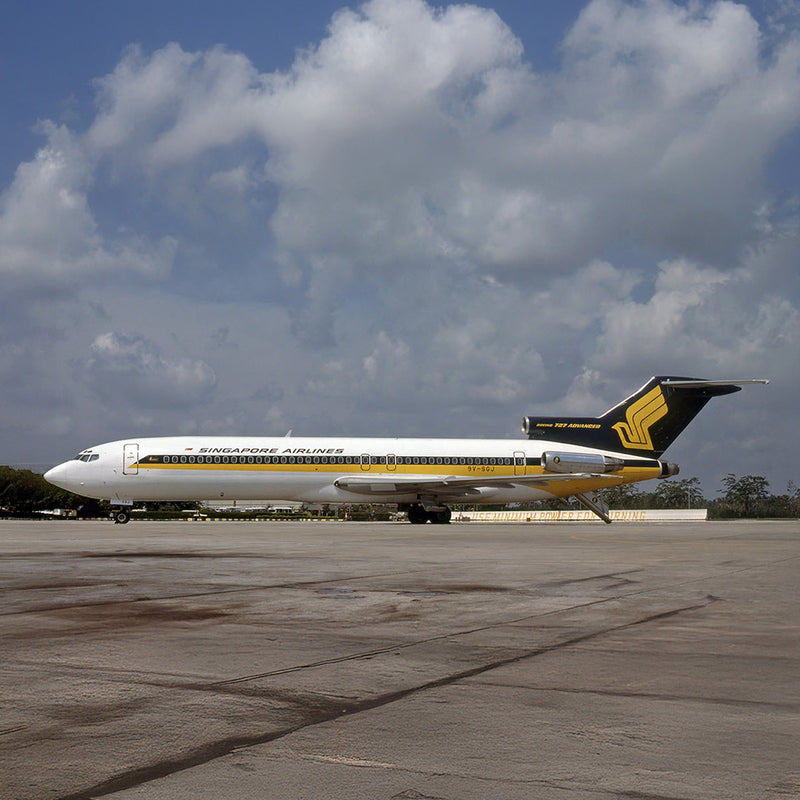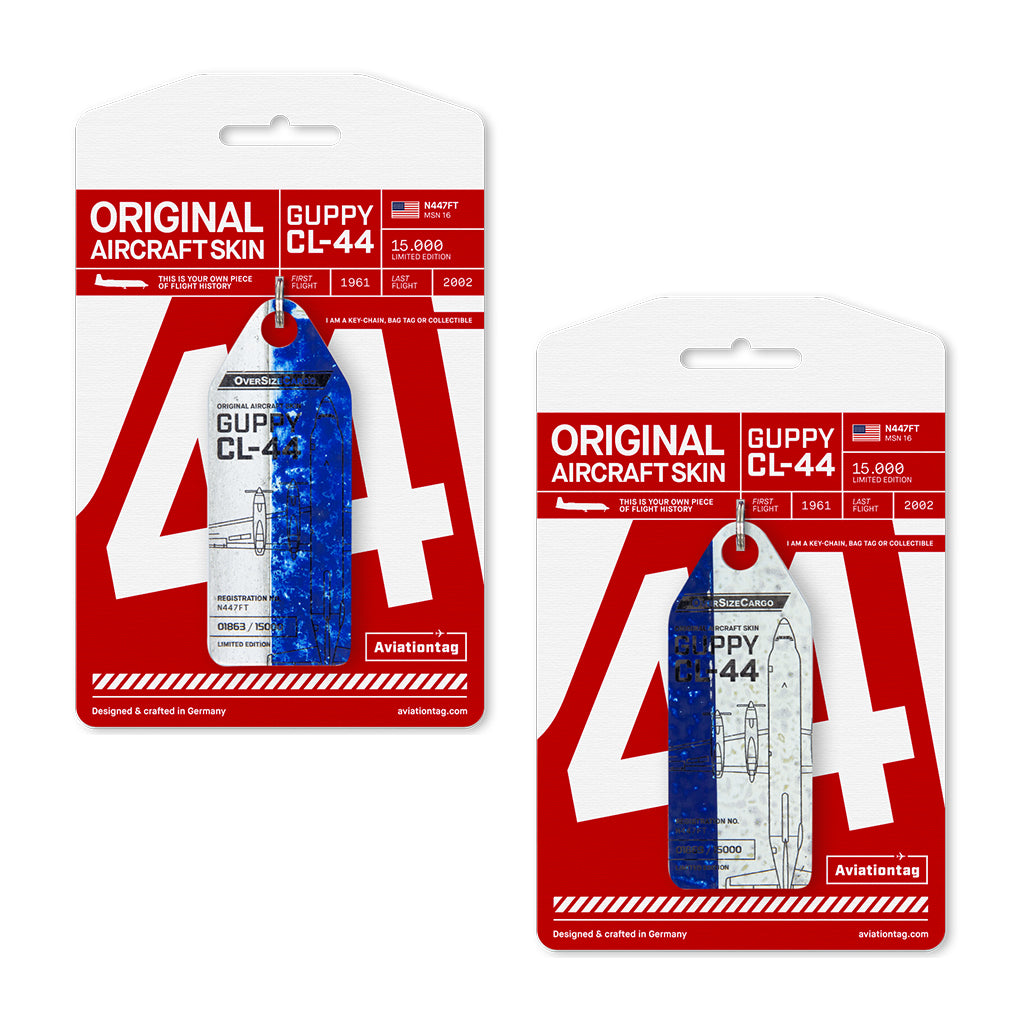At Aviationtag, each tag tells a story — and few stories are as compelling as that of the Boeing 727 VP-CMO. From its origins as a commercial airliner to its transformation into a high-end VIP jet, this aircraft carried decades of aviation history across continents. Through our upcycling process, parts of its fuselage now live on, offering collectors a tangible piece of a truly unique legacy.

The Boeing 727-212 with manufacturer’s serial number 21948 rolled off Boeing’s production line in July 1979 and was delivered on August 1, 1979 to Singapore Airlines, entering service as 9V-SGJ. In Singapore Airlines’ fleet, it operated regional passenger flights, typical for the carrier’s 727s at the time, until the mid-1980s when the airline began phasing out the tri-jet in favor of newer aircraft.
In March 1985, the aircraft found a second life with Alaska Airlines, re-registered as N310AS for use on the airline’s US routes. Alaska Airlines only kept the 727 in operation for a short period – by that December 1985 it was withdrawn from their fleet. The brief stint in Alaska’s colors was likely a stopgap lease or trial, which was not uncommon as carriers transitioned fleets in the 1980s.
By the end of 1985, the Boeing 727 left commercial airline service and entered the world of private and executive aviation. The jet was acquired by TAG Aviation, a company renowned for managing business jets, initially still carrying its U.S. registration N310AS. Plans were set in motion to transform the former airliner into a lavish VIP transport. In 1987, the aircraft underwent an extensive conversion to VIP configuration. Around the same time, its registration moved to the Cayman Islands (a common registry for corporate jets), changing from the U.S. “N-number” to VR-COJ under TAG Aeronautics. This re-registration coincided with the completion of the luxury refit, effectively marking the 727’s new identity as a private jet for the elite.
To remain viable and compliant into the 1990s, the Boeing 727 VP-CMO underwent significant performance and noise-reduction upgrades as well. The aircraft was converted to a “Super 72/27” variant – an unofficial designation for 727-200s that were re-engined and modified for better performance. This typically involved replacing the two outboard Pratt & Whitney JT8D engines with more powerful, modern versions (such as the JT8D-217 series) and adding hushkits to the center engine to meet stricter Stage III noise regulations.
On VP-CMO, these modifications were implemented during its tenure as a corporate jet. Notably, the plane was fitted with winglets on its wingtips as part of the upgrade, improving aerodynamic efficiency and giving the classic trijet a fresh look. The enhanced engines provided additional thrust and fuel efficiency, especially useful for “hot and high” operations and extended range flights. With the Super 27 / 72 package, the 727 could fly farther on a given fuel load and operate from airports with tougher noise restrictions – a crucial factor as older jets faced new rules in the 1990s.
By February 1989, the aircraft was being operated by Triangle Aviation Services of West Palm Beach, FL, and was re-registered in the U.S. again as N31TR. Triangle Aviation, and later its successor corporate owner 280 Holdings LLC, continued to utilize the 727 in the VIP charter role throughout the 1990s. During these years, the jet likely transported heads of state, royalty, business magnates or even occasional music and sports tours –essentially serving as a global executive shuttle. Specific assignments remain confidential, but the aircraft’s globe-trotting missions would have spanned from North America and Europe to the Middle East and Asia, given the demand for large VIP jets in those regions.

Aviationtag Classic Aircraft Edition
The interior of VP-CMO was rebuilt to embody a flying luxury apartment, featuring high-end furnishings and amenities. The cabin was appointed with rich wood veneers throughout and configured for 32 seats in an executive layout.
Of these, 19 seats were equipped with seatbelts and certified for use during takeoff and landing – the remainder included divans and lounge chairs intended for in-flight use only. The design included a spacious main salon (lounge area) for meetings and relaxation, as well as a private master stateroom with its own en-suite lavatory and shower.

Key features of the VIP configuration included:
Expansive Lounge: A forward salon with comfortable club seating and sofas, allowing several passengers to converse or work in a living-room-like setting. The décor featured fine hardwood finishes throughout the cabin, creating an ambiance of a luxury hotel.
Private Bedroom Suite: A completely enclosed master bedroom located toward the rear of the cabin, furnished with a full-size bed. Adjoining was a VIP bathroom equipped with a shower – a rarity on aircraft in the 1980s – giving the principal traveler hotel-like comfort and privacy.
Seating Capacity: A total of 32 seats for passengers and staff in various configurations, from plush swiveling armchairs to divans. Nineteen of the seats could be used during taxi, takeoff and landing, having been properly certified with restraints.The remaining seating provided additional comfort during cruise.
Onboard Technology: The aircraft was outfitted with then-state-of-the-art avionics and communications for its role. It boasted a satellite communications (SatCom) system for phone connectivity, a Honeywell Primus 880 color weather radar, and an advanced Mark VII EGPWS (Enhanced Ground Proximity Warning System) for terrain awareness and safety. Such equipment was cutting-edge for a private jet in that era, underscoring the 727’s dual role as both luxurious and capable.
End of an Era: Retirement and Fate
By 2009, after three decades aloft, the venerable 727 was approaching the end of its flying life. On July 7, 2009, the aircraft changed hands for the last time – MK Airlines, a cargo carrier, became the registered owner (through a trustee company). The U.S. registration N31TR was cancelled on July 23, 2009 as the aircraft was exported to the Cayman Islands and reassigned the registration VP-CMO. It was an unusual acquisition, as MK Airlines was known for freight operations (using 747s and other cargo jets); it’s speculated that the 727 might have been intended for an executive charter venture or simply as an opportunistic purchase for resale or conversion to a freighter. In any case, VP-CMO never entered active service for MK.
The aircraft spent some time parked at Biggin Hill Airport in the UK. In late July 2009, the 727 was reportedly ferried to Amman, Jordan, perhaps for storage or inspection, and then returned to the UK. VP-CMO wasflown into Lasham Airfield in Hampshire, England. Lasham is a known site for aircraft maintenance, storage, and parting-out. Indeed, this flight would be the jet’s final journey. At Lasham, the once-proud VIP airliner was gradually stripped of useful parts and used for some ground training exercises.

By April 2014, the decision was made to permanently withdraw the aircraft from use and scrap it. The wings and tail were removed, and the airframe was dismantled on site. However, a significant portion of the fuselage remained intact and was left lying in the grass at Lasham for years afterward – a ghostly reminder of the aircraft’s former glory. In fact, as of the early mid-2020s, the hulk of VP-CMO’s fuselage could still be seen on the field, its once-luxurious interior long gone and exposed to the elements.
Pieces of its fuselage skin have even been sold as aviation memorabilia to collectors,allowing its legacy to quite literally live on as display artifacts. Aviationtag was fortunate to receive a section of the original fuselage skin, which has now been upcycled into collectible tags. In this way, a piece of the aircraft continues its journey – not in the skies, but in the hands of those who appreciate its story.
From the runways of Singapore to the skies over Alaska, the Boeing 727 VP-CMO lived many lives – from commercial workhorse to bespoke VIP jet. Now, through Aviationtag’s upcycling of its fuselage, a piece of that story continues.
What are your memories of the 727? Share them with us in the comments.









